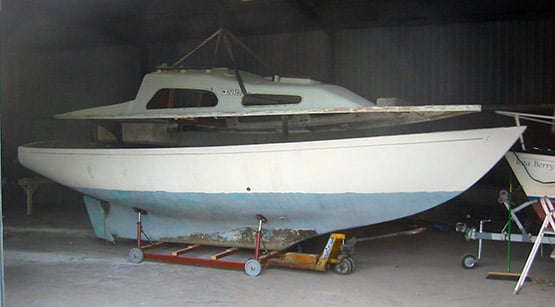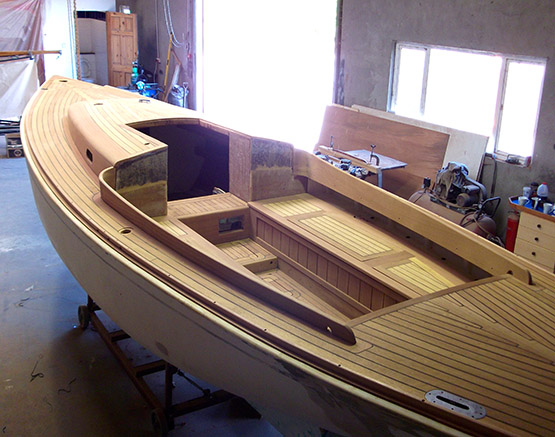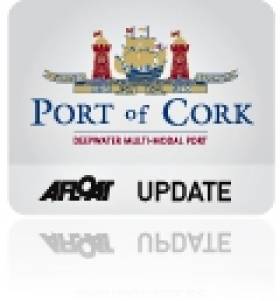Displaying items by tag: safehaven
Ireland’s Individuality In Boats Is Our Answer To The World’s Uniformity
Located on the fringes of Europe and set in challenging seas, Ireland does not offer an ideal setup for large-output series-production of recreational boats. We lack the economies of scale which are conferred on giant production companies in the crowded heartlands of Europe. There, the ready potential of a vibrant and easily-accessed market is allied with the availability of skilled workforces which are prepared to undertake the tasks in regimented and regulated settings. While these modern production plants may provide bright and well-ventilated conditions, nevertheless they’re markedly industrial in tone and style, and maybe not really in tune with much of life in our own highly individualistic island. W M Nixon takes a look at some of the stories of boat-building in Ireland, and reckons from current experience that specialized work is what we do best.
Despite the less-than-ideal conditions, over the years enthusiasts have given the Irish production fiberglass boat-building challenge their best shots. The continuing and much-enjoyed presence of boats of the Shipman 28 class at many of our sailing centres is a reminder that once upon a time, from the 1970s onwards in Limerick, there was a company called Fibreman Marine, later Fastnet Marine, which built the Swedish-designed Shipman 28 and then expanded the range to include the Fastnet 24, designed by Finot of France.
At much the same time, the Brown brothers were building the Ruffian range – of which the most popular was the Ruffian 23 – in their home town of Portaferry on Strangford Lough, while across the Lough at Killyleagh, Chris Boyd – who’d actually built the first Puppeteer 22s in Larne – set up shop a couple of years later in a new mini-factory and Puppeteers of several sizes rolled off the line.
Meanwhile on the shores of Cork Harbour, a popular range of variations on the Ron Holland Shamrock Half Ton design kept a harbour-side production plant busy for some years. And out west in Tralee, O’Sullivans Marine found themselves some decades ago in the forefront of design development with a new GRP National 18 built around the enthusiasm of the Cork Harbour fleet, and then they went on to build large numbers of the Tony Castro-designed 1720 Sportsboat. But having started as builders of smaller craft with a useful range of elegant lakeboats, they find that the lakeboat is what keeps them going today – it’s a case of going with the knitting while keeping well clear of more high-powered production temptations.
Other pioneers in Irish series boat-building have stayed in the marine business, but have moved their focus. How many know now that our very own marine conglomerate, BJ Marine with its wide boat-oriented interests at home and abroad, started life as a boat-building company with a range of van de Stadt GRP hulls, and then continued as the builder of the Ruffian 23?
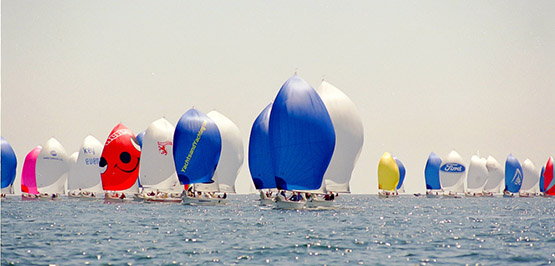 God be with the days…..seventy Tralee-built 1720s racing at Cork Week 2000, with Mark Mansfield the winner and Anthony O’Leary second. Photo: Robert Bateman
God be with the days…..seventy Tralee-built 1720s racing at Cork Week 2000, with Mark Mansfield the winner and Anthony O’Leary second. Photo: Robert Bateman
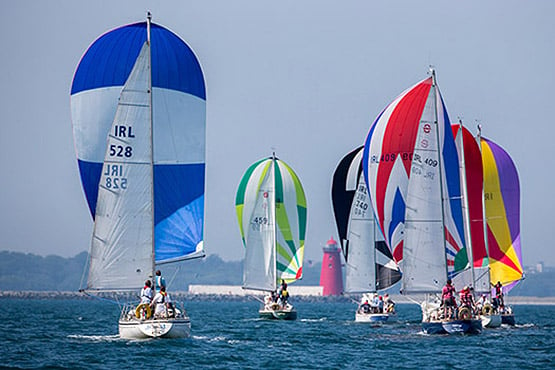 Shipman 28s racing in Dublin Bay. They were built in Limerick in one of several factories in Europe which between them produced 1300 of these boats. Photo: Courtesy VDLR
Shipman 28s racing in Dublin Bay. They were built in Limerick in one of several factories in Europe which between them produced 1300 of these boats. Photo: Courtesy VDLR

Ruffian 23s in Dun Laoghaire Harbour. Originally built in Portaferry to be a Belfast Lough class, at their height they were raced at about ten centres including Hong Kong, but now their most resilient strongholds are Dun Laoghaire and Carrickfergus.
Indeed the story of BJ Marine is in many ways the story of the Irish marine industry, for as the late Dickie Brown of Ruffian fame said of the glory days of their little firm of Weatherly Yachts: “We were the right people in the right place at the right time in the rapidly developing international marine industry. But later, there was no way a little local firm could hope to compete with the giants of the industry in the production of what was, in effect, the sailing equivalent of the small family car.”
It wasn’t just on the coast that semi-production boatbuilders were thriving - or at least surviving - at this particular stage of the Irish marine industry’s development. On the inland waterways, particularly around Carrick-on-Shannon there were firms of all sorts, mainly building motor-cruisers, but as well the great pioneer, O’Brien Kennedy, having come home to build Shannon cruisers, then returned to his first love of sailing boats and created the Kerry 6-tonner, characterfully built in GRP of simulated clinker construction, and still much-loved even if Kennedy International Boats is a long-gone memory.
But since the heady days of the 1970s, ’80s and ’90s, several economic storms and revolutions in production methods and materials have blown away much of the Irish marine manufacturing and boat-building industry. The crazy years of the Celtic Tiger only emphasized its demise, as the great waves of new boats joining the Irish fleet were almost entirely imported, while the concurrent property boom meant that even the humblest waterfront boatyard provided other-use high-end development potential which so quickly pushed prices through the roof that anyone who wanted to work at or build boats had to think in terms of finding premises just about as far as they could be from desirable waterside facilities, for that was all that could be afforded.
And yet, some companies have come through. Red Bay Boats in County Antrim started in 1977 as builders of standard little angling craft, but they soon saw the potential of RIBs, and now they’re world leaders. Having introduced a completely new kind of fast powerboat day cruising with their impressive range of multi-function RIBs, they soon realized that today’s people in a hurry want a complete package. So in Cushendall, Red Bay Boats will provide shore storage for your boat when you’re not using it, yet when you carve out one of those short-break holidays which are the way we live today, they’ll have your boat ready and waiting for instant launching, and off you go for a high speed cruise among the Scottish Hebrides – they’ll even organise cruises-in-company.
Across Northern Ireland on Lough Erne, the Leonard family of Carrybridge have taken over Westwood Marine from its production facility in England, and since 2013 have been re-establishing the production line in ideal premises – a former aircraft hangar at the lakeside St Angelo Airport on the Enniskillen-Kesh road. Westwood’s designer is the versatile Andrew Wolstenholme, whose astonishing variety of craft includes the hefty steel 57ft cruising barge-style yacht Ida for Tom & Dee Bailey of Lough Derg. It was a designer-client relationship which was remarkably fruitful, as the only real stumbling block was Dee’s insistence that the boat include a really good full size hot press - it took some time for the very English designer to grasp that she meant an airing cupboard.

One example of Wolstenholme design – the 57ft barge yacht Ida (Tom & Dee Bailey) on Loug Derg. Photo: Noel Griffin
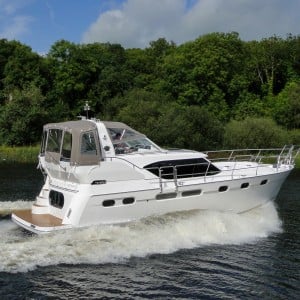
A very different example of Wolstenholme design – the Westwood A405 is now being built in Enniskillen.
For Westwood in their new Enniskillen base, Wolstenholme has been showing his skills in contemporary design with a complete revamp of materials used in the interior, but by any standards the Westwood A405 is a handsome modern craft, and anyone buying a new one from Enniskillen has the bonus of a year’s free berthing on Lough Erne.
Down at the other end of the country, adverse conditions is what keeps Safehaven Marine going strong. Everyone will be familiar with the dramatic videos of their pilot and patrol boats leaping abut like happy porpoises in the breaking water at the entrance to Cork Harbour when there’s a storm force southerly against the spring ebb. But by contrast, a visit to their production facility in Youghal is a soothing experience (once the enormous guard dog has accepted you’re a temporary part of the team), as it’s a sort of mini-cathedral of boat-building where craft capable of taking anything the sea can throw at them are built with meticulous attention in which the only noise comes when the vast extractor fans are activated. Building boats in modern plastics is inevitably a dusty business, and anyone who has worked at it will be fully appreciative of what Frank Kowalski has installed in Safehaven to keep the busy place dust-free.
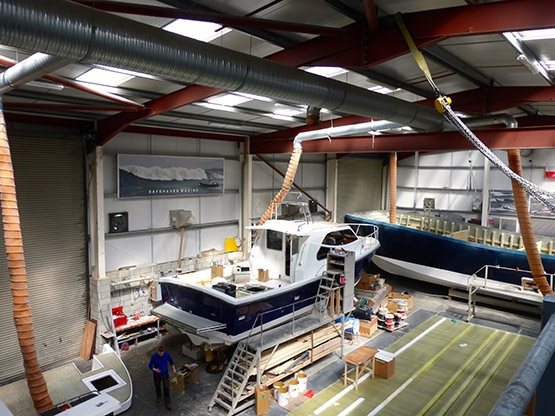
However, having a setup like this implies the building of high ticket boats in which expense is virtually no object if it can be guaranteed that they’ll fulfill their very special purposes. But for the vast majority of specialist boatbuilders – both professional, semi-professional, and amateur – it’s a case of making do as best you can, and often you’ll find rather special boat being built in unlikely places, often to the extent that the locals don’t known what’s going on, for in some cases they’ll barely know what a boat is in the first place.
From time to time we’ve given away snippets of information abut Jarlath Cunnane’s new 37ft alloy Atkins ketch which he has been building himself in a very hidden little shed beside a drainage canal on Clew Bay. Jarlath of course built the ice-voyaging Northabout - also in alloy - with Paddy Barry and circled the Arctic Circle with the project completed in 2005. But now that the likes of top Chinese skipper Guo Chuan are breezing their way through the Northeast passage in a giant trimaran in a fast sail of a couple of weeks, Jarlath has moved on. Northabout has been sold to be a expedition vessel in Antarctica (her last Irish port was Kilrush in May) – and the new schooner Island Princess is handling a treat, and moving at leisure among the islands of Connacht, while the hidden shed is given over to other business.

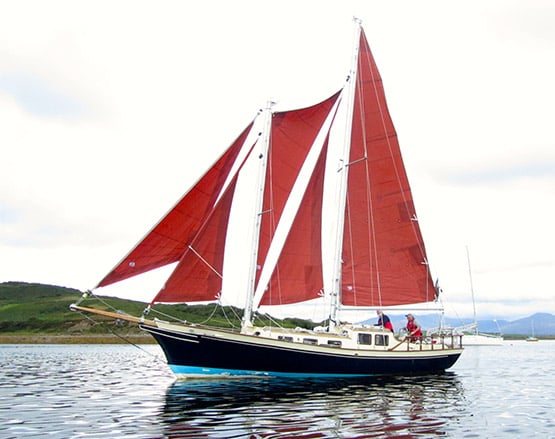 Jarlath Cunnane’s new Island Princess is just about as different as possible from his previous expedition boat Northabout except that she too is built in alloy.
Jarlath Cunnane’s new Island Princess is just about as different as possible from his previous expedition boat Northabout except that she too is built in alloy.
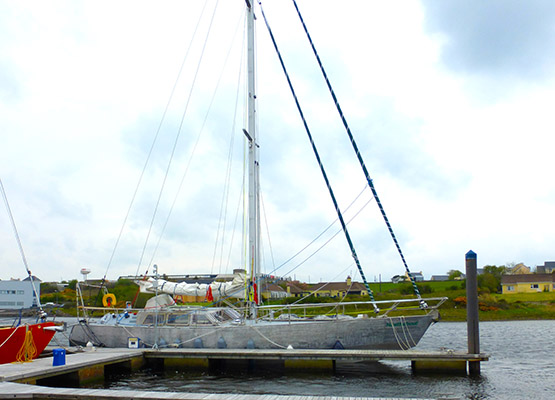
But deep in the heart of north county Cork, just about midway between Cork Harbour and Limerick, there’s a fine shed ready and waiting for the next bit of business. And the more unusual your requirements, the more interested Bill Trafford will be in doing it at Alchemy Marine, where he successfully completes boat projects which are so far off the wall that they’re over the hills and well into the next county.
Those of us who are into interesting boats will know that the most dangerous road in Ireland is the one from Carrigaline to Crosshaven, for the further along it you get, the more boats you will see moored in and around Drake’s Pool. They’re a briefly-glimpsed eclectic collection of boats of all ages, shapes and sizes, which means you’re constantly trying to see them while supposedly driving the car at the same time, which is not a good idea at all.
But back in August, the road along the north side of Crookhaven in far west Cork also became a Highway of Hazard. I always have a soft spot for any boats with the good sense to moor on the north side of Crookhaven, for although you’re not even half a mile from the much more fashionable and crowded anchorage off the village, you’re out of the tide. When the flood is making against a stonking westerly, the village anchorage is irritatingly uncomfortable, but a quick move, dropping the visitor’s mooring off the village, and then deploying our oversize windlass and ground tackle at the press of a button over to the north, and Bob’s you uncle, dinner can continue in total serenity.
So anyway one evening last August we were trundling eastward along the road looking favourably on the little group moored in towards Rock Island, and there among them was this heart-stoppingly beautiful little dark blue sloop which looked so much of a piece that I assumed she must be one of those incredibly pricey little semi-customised dayboats which top-end American builders up in Maine might occasionally produce at enormous expense, and even then only for very favoured customers.
Couldn’t have got it more wrong. Turns out she’s a completely re-booted Elizabethan 23 which Bill Trafford of Alchemy Marine up near Doneraile had been hoping to have re-crafted for a discerning owner from Crookhaven Harbour Sailing Club in time to make her debut at the Glandore Classics in July. But you can’t rush the final stages of a job like this for something so vulgar as a deadline, so Kioni quietly made her debut in West Cork in August, and she is simply amazing.
The Trafford speciality is seeing unexpected potential in glassfibre hulls of a certain age, for what he’s looking for is boats that look like yachts, with proper curved garboards and an encapsulated lead ballast keels. We now know that good glassfibre can last for ever, but in many cases the finish didn’t do justice to the superb materials in the original hull. But with more than a bit of tweaking, a beautiful butterfly can emerge from a very ordinary chrysalis.
Not that the Elizabethan 23 wasn’t something quite special in her day, which was 1969. Boatbuilder Peter Webster of Lymington was originally a baker in Yorshire, but he only wanted to builld boats, and he knew Lymington in Hampshire was the place to do it, and having a marina there – Lymington Yacht Haven – would provide the cash flow to support the boat-building. He started with the ground-breaking GRP Elizabethan 29 designed by Kim Holman, which set herself on the high road to success with major wins in Cowes Week and the Round the Island Race. But then Webster got some notions for a centreboard 23-footer, for which he sketched out rough drawings and then persuaded up-and-coming Welsh yacht designer David Thomas to put manners on them, with the result being the pretty-enough Elizabethan 23.
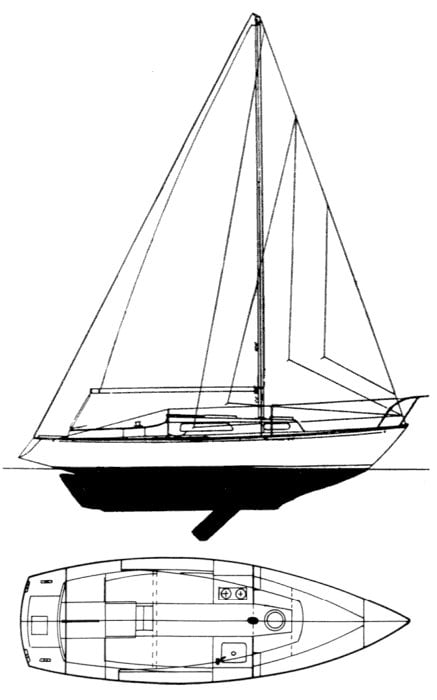 The original design for the Elizabethan 23 had this reasonably conservative coachroof…
The original design for the Elizabethan 23 had this reasonably conservative coachroof…
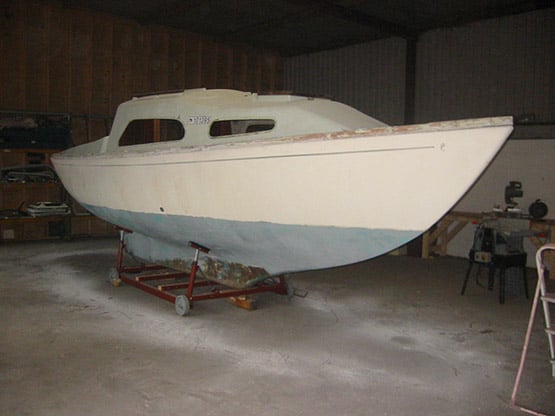
First big job is to remove deck and coachroof, revealing a rather nice hull underneath
The duo’s most successful combined effort was the Elizabethan 30, which did well in Half Ton racing and was a superb little cruiser-racer generally, so much so that Webster’s pet boat was the bright red Elizabethan 30 Liz of Lymington which he sailed to the end of his days, and then left in his will to David Thomas, who then did the same, and he died well advanced in years last winter.
But meanwhile the mouldings for the Elizabethan 23 had been taken over by another builder who reckoned the enlargement of the coachroof was the only way to go, and it was in one of these boats with its Acropolis on top that Bill Trafford saw the potential to provide a sweet little 26ft day-boat, though with a couple of bunks, a proper sea toilet, and an inboard diesel, for the clear-headed Crookhaven Harbour sailor.
They defined lines of negotiation between what Bill wanted to do, and what the owner required, and work proceeded apace. The photos says it all. Kioni speaks for herself. And there is no doubt but that Bill Trafford’s eye for what a proper yacht should look like is world-class-plus.
Perhaps the most crucial job of all – getting the counter extension just right. Bill Trafford hit the target perfectly.
Bill Trafford’s eye for a boat is well matched by his skill in working with wood – we can see only one glaring design fault in this photo in the workshop as Kioni take shape in her new form.
The skill in getting the counter extension just precisely right sets the tone of the entire project. And as for the quality of the workmanship in wood – that’s truly a wonder to behold. But what’s this about a design fault in that nearest photo above? Not to worry – it’s not in the boat. It’s to do with the door to the workshop lavatory.
That great boat designer and builder Uffa Fox says in one of his books that whether it’s the privy in the garden, or the lavatory in the boatbuilding shed or wherever, then the door to the lavatory should always open inwards. Thus if you’re taking your proper leisure therein, and seated comfortably and wish to contemplate some good work whether it be in the garden or on the boat under construction in the workshop, then if you’re on your own you can leave the door open the better to appreciate your work. But if someone arrives unexpectedly, you can kick it shut without a bother…….
Although Kioni makes a feature of beautifully finished timberwork, it’s not excessive. The really skilled boat creator knows that less is more, and a discreet yet effective little toe rail is much more pleasing to the eye than some hulking great heavy bit of bulwark or beading.
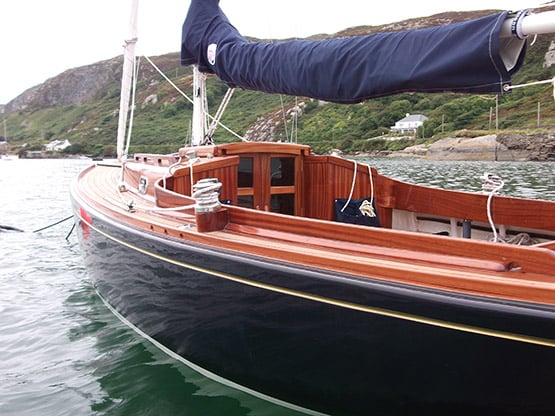
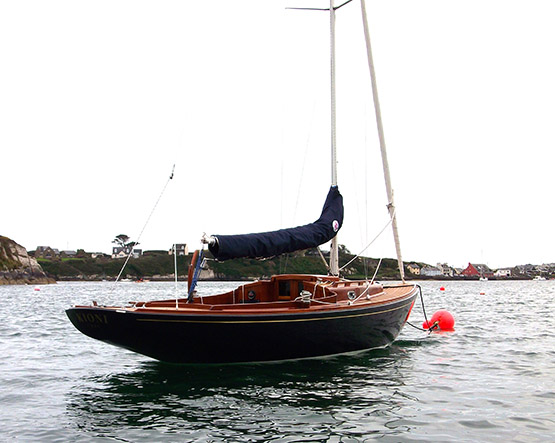
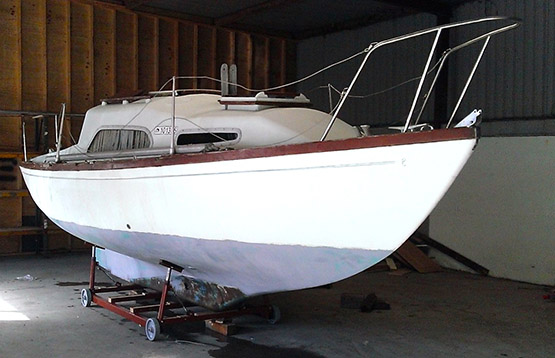
……came from this
So now you know the style of Bill Trafford’s work, and if you’re interested, his workshop is 70ft X 45ft with a door 15ft wide and 14ft high. He reckons he could do two Kionis a year. But be warned. He always has some other ideas at the back of his mind. His real ambition is to buy a battered old GRP Nicholson 43, lengthen her stern out into something like a Fife counter, give her straight stem the tiniest hint of a clipper bow, stick on an 8ft bowsprit, and turn her into a re-born gaff schooner…………
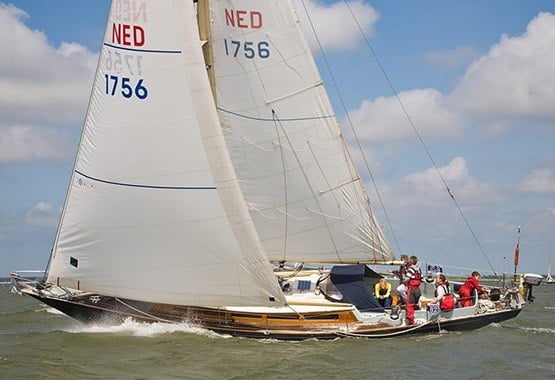 A standard Nich 43. Bill Trafford’s dream would be to turn her into a 47ft gaff schooner with a classic long Fife counter and a hint of a clipper bow
A standard Nich 43. Bill Trafford’s dream would be to turn her into a 47ft gaff schooner with a classic long Fife counter and a hint of a clipper bow
New Pilot Boat 'Failte' Gets a Big Cork Harbour Welcome
#corkharbour – Failte is the appropriate name for the first Irish boat most foreign ships and cruise liners will meet when they enter Cork harbour. The Port of Cork today officially named a new pilot boat at the Port of Cork City Marina. Built by Safehaven Marine, "Failte" will be replacing the "Sonia" which was named after Sonia O'Sullivan and has served the Port gallantly for the past fourteen years.
Dermot O'Mahoney, Chairman of the Port of Cork said "An Irish welcome is synonymous with the Port of Cork and reflects our attitude to all vessels that call to our harbour so it is fitting that we are christening our new pilot boat "Failte" today".
Captain Pat Farnan, Harbour Master and Deputy Chief Executive of the Port of Cork continued "Our pilots and launch crew provide a service that is second to none. Their skill and seamanship has seen some of the world's largest vessels such as the "Queen Mary 2" and the "Independence of the Seas" navigated safely in and out of our Port and I have no doubt "Failte" will serve the Port well for many years to come. The launches are required to operate in all weather conditions, 365 days a year and must be built to a very high standard to make this possible."
Safehaven Marine is a local Cork based company, employing 25 staff in Little Island and Youghal. Since the company was founded in 2008, they have supplied pilot boats to countries across the globe from Scandinavia to the Middle East and are now one of Europe's leading manufacturers of GRP pilot boat.
Safehaven Marine, Managing Director Frank Kowalski commented "We are delighted to once again be supplying the Port of Cork's new pilot vessel, "Failte" having also built their last new pilot boat, the "Gleann Mór" six years ago. It is extra special for us to be working with our local Port in delivering this vessel, which is a proud example of our high level design and engineering."
The pilot launches undertake in excess of 3,000 services per annum to vessels of all types including cruise ships and cargo vessels.




























